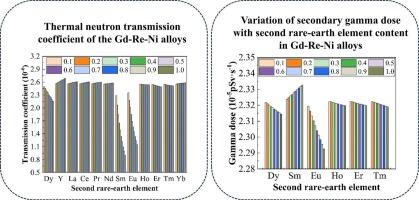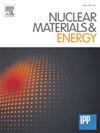稀土镍合金材料的热中子屏蔽性能
IF 2.7
2区 物理与天体物理
Q1 NUCLEAR SCIENCE & TECHNOLOGY
引用次数: 0
摘要
研究了稀土镍合金的热中子屏蔽性能,重点研究了不同稀土元素及其浓度对中子透射系数的影响。在镍基合金GH3535中掺杂单、二元稀土元素,合金厚度为0.5 cm。利用蒙特卡罗模拟方法对热中子透射系数进行了评估。分析的关键参数包括宏观吸收和散射截面、二次伽马剂量和反冲电子的位移辐射损伤。结果表明,GH3535中的热中子主要通过散射损失能量,透射系数高达7.24 × 10−1。热中子显微吸收截面最大的稀土元素钆(Gd)掺入GH3535后,形成单稀土镍合金Gd- ni。Gd的引入显著增强了Gd- ni合金的吸收能力,在Gd为1.50 wt%时,透射系数为2.52 × 10−6,二次γ剂量为2.32 × 10−5 pSv·s−1。在二元Gd-Ni合金中进一步掺杂其他稀土元素,如钐(Sm)、铕(Eu)和镝(Dy),形成二元稀土镍合金Gd-Re-Ni,大大提高了屏蔽效能。与Gd- ni合金(1.5 wt% Gd)相比,热中子透射系数降低了64.47% (1.0 wt% Sm), 54.68% (1.0 wt% Eu)和15.13% (1.0 wt% Dy)。次级γ剂量随不同的掺杂剂而变化,而Eu在1.0 wt% Eu下显著降低了γ暴露,剂量为2.29 × 10−5 pSv·s−1。同时,Eu、Sm和Dy的掺入降低了Gd-Re-Ni合金的原子位移(DPA),增强了其抗辐照损伤能力。研究表明,稀土元素(尤其是Eu和Dy)的加入显著增强了镍合金的热中子屏蔽能力,同时降低了二次γ辐射和辐照损伤。这些发现为先进中子屏蔽材料的设计和应用提供了重要的理论支持。本文章由计算机程序翻译,如有差异,请以英文原文为准。

Thermal neutron shielding properties of rare-earth nickel alloy materials
The thermal neutron shielding performance of rare-earth nickel alloys are investigated, specifically focusing on the influence of various rare-earth elements and their concentrations on neutron transmission coefficients. The nickel-based alloy GH3535, with a thickness of 0.5 cm, was doped with mono or binary rare-earth elements. The thermal neutron transmission coefficients were assessed using Monte Carlo simulation methods. Key parameters analyzed included macroscopic absorption and scattering cross-sections, secondary gamma dose, and displacement radiation damage from recoil electrons. The results reveal that thermal neutrons in GH3535 primarily lose energy through scattering, allowing for a high transmission coefficient of 7.24 × 10−1. The incorporation of gadolinium (Gd), a rare-earth element with the largest thermal neutron microscopic absorption cross-section, into GH3535 forms a mono rare-earth nickel alloy, Gd-Ni. The introduction of Gd significantly enhanced the Gd-Ni alloy’s absorption capacity, achieving a transmission coefficient of 2.52 × 10−6 at 1.50 wt% Gd, with a secondary gamma dose of 2.32 × 10−5 pSv·s−1. Further doping of binary Gd-Ni alloys with other rare-earth elements, such as samarium (Sm), europium (Eu), and dysprosium (Dy), formed binary rare-earth nickel alloys Gd-Re-Ni and substantially improved shielding effectiveness. Compared to the Gd-Ni alloy (1.5 wt% Gd), the thermal neutron transmission coefficients were reduced by 64.47 % (1.0 wt% Sm), 54.68 % (1.0 wt%, Eu), and 15.13 % (1.0 wt%, Dy). The secondary gamma dose varied with different dopants and Eu notably minimized gamma exposure yielding a dose of 2.29 × 10−5 pSv·s−1 at 1.0 wt% Eu. Meanwhile, doping with Eu, Sm and Dy reduced the displacement per atom (DPA) in the Gd-Re-Ni alloy, thereby enhancing its resistance to irradiation damage. The study demonstrates that the incorporation of rare-earth elements, particularly Eu and Dy, significantly enhances the thermal neutron shielding capabilities of nickel alloys while reducing secondary gamma radiation and irradiation damage. These findings provide essential theoretical support for the design and application of advanced neutron shielding materials.
求助全文
通过发布文献求助,成功后即可免费获取论文全文。
去求助
来源期刊

Nuclear Materials and Energy
Materials Science-Materials Science (miscellaneous)
CiteScore
3.70
自引率
15.40%
发文量
175
审稿时长
20 weeks
期刊介绍:
The open-access journal Nuclear Materials and Energy is devoted to the growing field of research for material application in the production of nuclear energy. Nuclear Materials and Energy publishes original research articles of up to 6 pages in length.
 求助内容:
求助内容: 应助结果提醒方式:
应助结果提醒方式:


